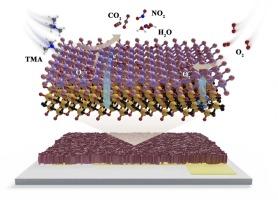室温下Ti3C2Tx/SnS2二维界面增强电子输运用于三甲胺的高选择性检测
IF 3.7
1区 化学
Q1 CHEMISTRY, ANALYTICAL
引用次数: 0
摘要
有效检测有毒气体对于监测空气质量和保障人类福祉和健康至关重要。气体传感器的性能取决于传感材料中载流子的输运效率。因此,我们提出了一种新的策略来增强室温下二维-二维界面选择性检测三甲胺(TMA)的电子传递。采用简单的一步水热法在二维Ti3C2Tx表面原位生长SnS2纳米片,并改变了Ti3C2Tx的用量。电子结构结果表明,Ti3C2Tx和SnS2在2D-2D界面上通过Ti-S共价键形成良好的化学键。该界面对TMA的检测具有较低的理论检出限(TMA LOD = 73.58 ppb),对TMA的选择性好,重现性好,长期稳定性好(运行30天后响应降低12.25%),响应值为27.98% (10 ppm),是纯SnS2 (7.33%, 10 ppm)的3.82倍。通过实验结果和密度泛函理论(DFT)模拟,阐明了二维界面上电子转移和表面吸附增强的潜在机制。本文章由计算机程序翻译,如有差异,请以英文原文为准。

Enhanced Electron Transport in 2D–2D Interface of Ti3C2Tx/SnS2 for Highly Selective Detection of Trimethylamine at Room Temperature
Efficient detection of toxic gases is essential for monitoring air quality and safeguarding human well-being and health. The performance of gas sensors is governed by the transport efficiency of charge carriers within the sensing material. Therefore, we propose a new strategy to enhance the electron transport in the selective detection of trimethylamine (TMA) at room temperature by a 2D–2D interface. It is demonstrated in an in–situ growth of SnS2 nanosheets on a two–dimensional Ti3C2Tx surface by a facile one–step hydrothermal method with varying the amount of Ti3C2Tx. Electronic structure results proves that Ti3C2Tx and SnS2 are well chemically bonded to each other via Ti–S covalent bonds in the 2D–2D interface. The detection of TMA facilitated by this interface has achieved a low theoretical detection limit (LOD for TMA = 73.58 ppb), excellent selectivity toward TMA, high reproducibility, and long–term stability (12.25% decrease in response after 30 days of operation), with a response value of 27.98% (10 ppm), 3.82 times higher than that of pure SnS2 (7.33%, 10 ppm). The underlying mechanisms of the enhanced electron transfer and surface adsorption at the 2D–2D interface are elucidated through both experimental results and Density Functional Theory (DFT) simulations.
求助全文
通过发布文献求助,成功后即可免费获取论文全文。
去求助
来源期刊

Sensors and Actuators B: Chemical
工程技术-电化学
CiteScore
14.60
自引率
11.90%
发文量
1776
审稿时长
3.2 months
期刊介绍:
Sensors & Actuators, B: Chemical is an international journal focused on the research and development of chemical transducers. It covers chemical sensors and biosensors, chemical actuators, and analytical microsystems. The journal is interdisciplinary, aiming to publish original works showcasing substantial advancements beyond the current state of the art in these fields, with practical applicability to solving meaningful analytical problems. Review articles are accepted by invitation from an Editor of the journal.
 求助内容:
求助内容: 应助结果提醒方式:
应助结果提醒方式:


